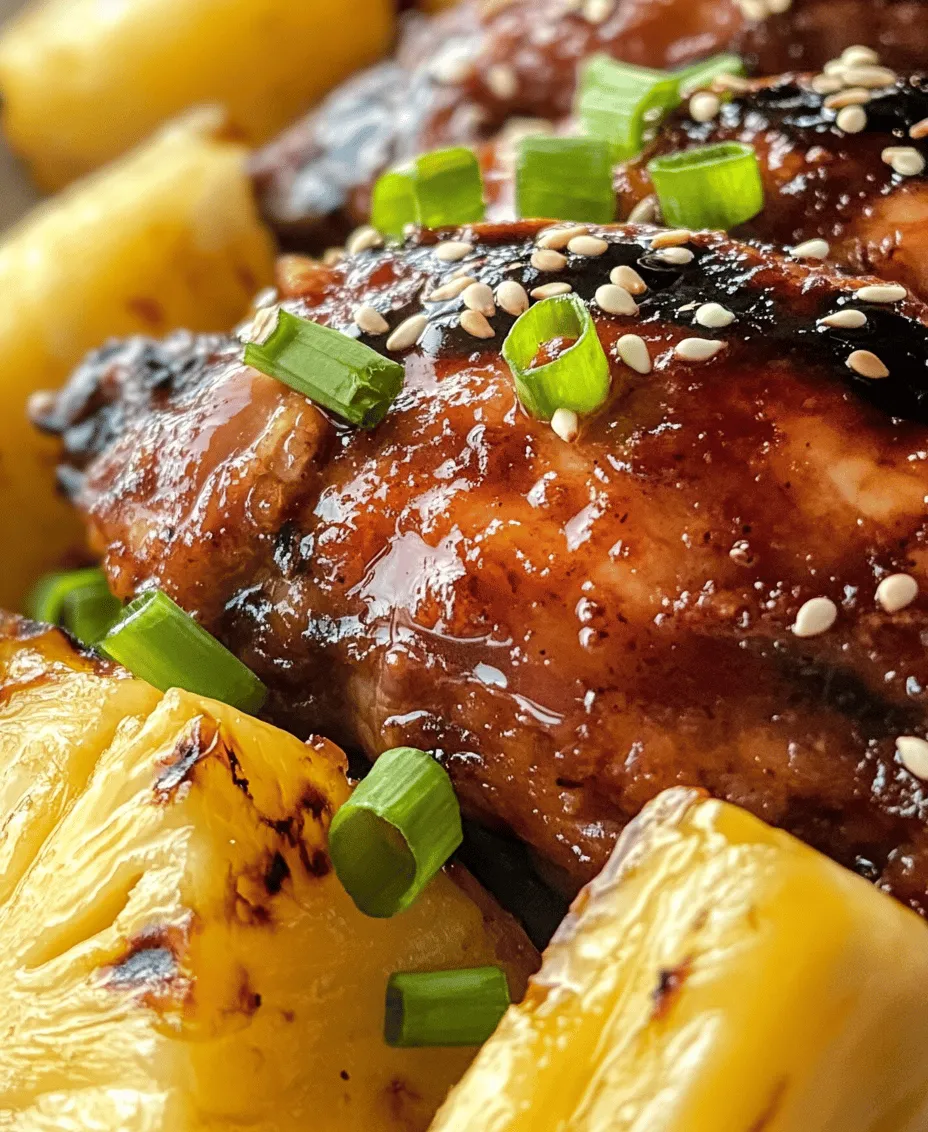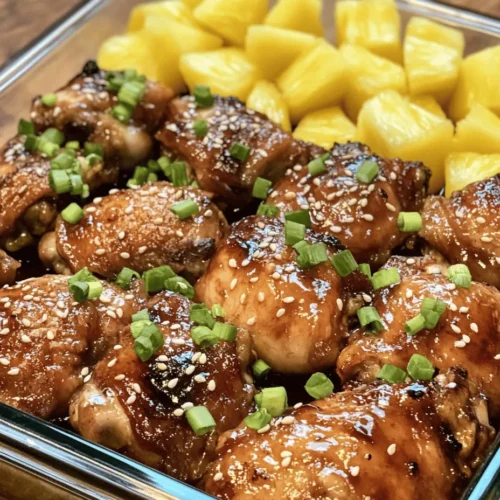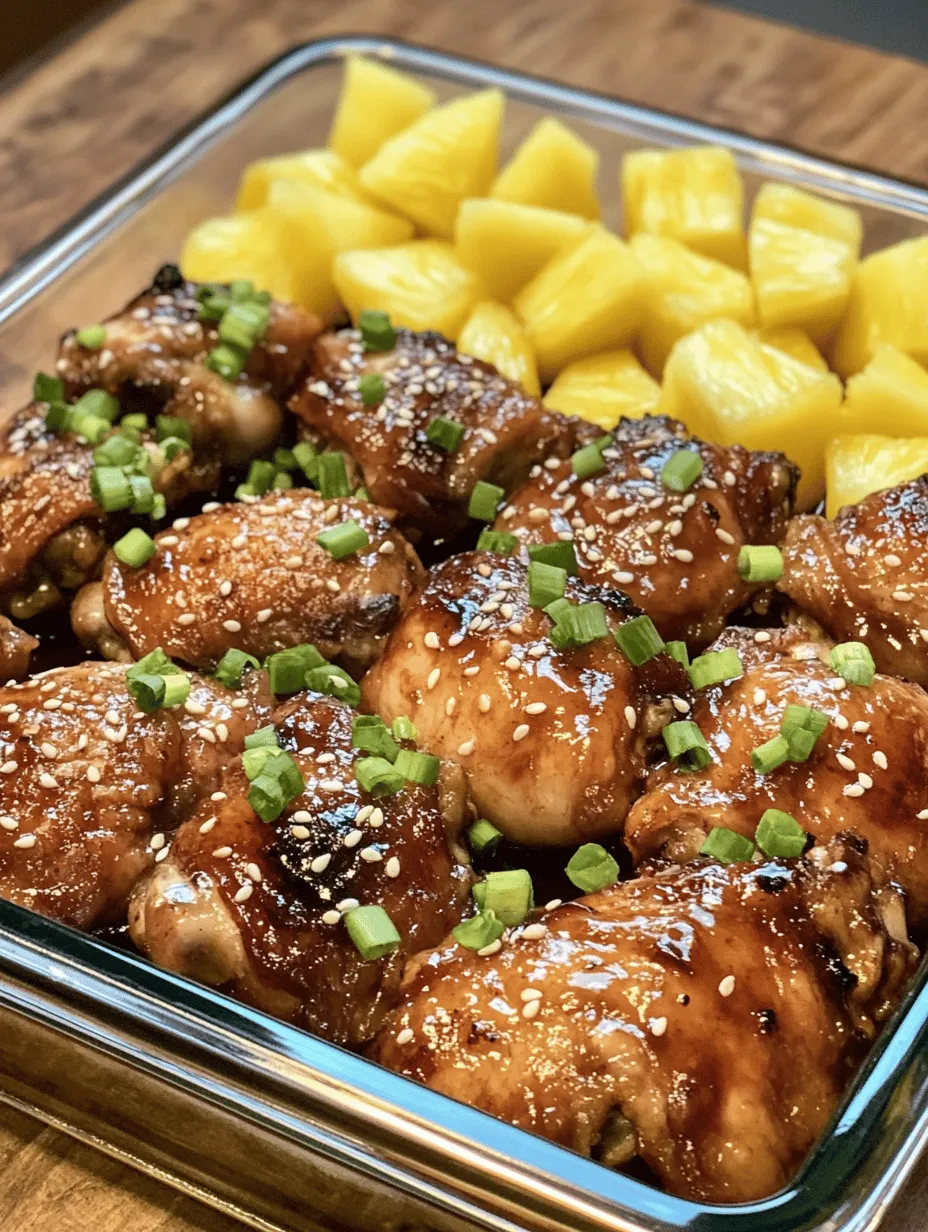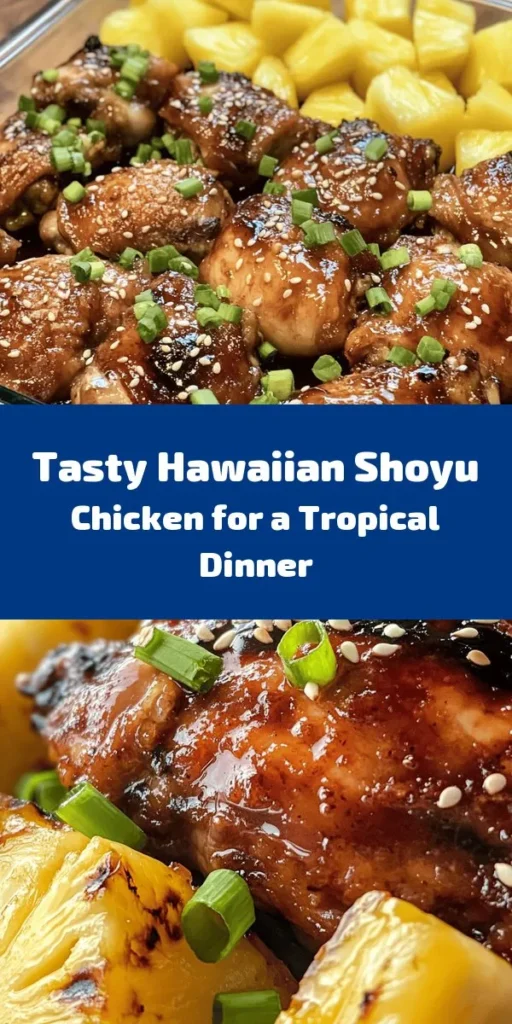Hawaiian cuisine is a vibrant tapestry of flavors, reflecting the rich multicultural influences that have shaped the islands over centuries. With roots in Polynesian, Asian, and American culinary traditions, Hawaiian dishes often showcase a unique blend of sweet, savory, and tangy flavors. Among the many delectable offerings, Hawaiian Shoyu Chicken stands out as a beloved dish, encapsulating the essence of island cooking. This recipe is not just a meal; it’s a celebration of family and togetherness, frequently served during gatherings and special occasions.
The Essence of Shoyu Chicken
At the heart of Hawaiian Shoyu Chicken is the harmony of flavors that come together to create a dish that is both satisfying and comforting. Shoyu, which is the Japanese word for soy sauce, plays a pivotal role in this recipe, providing a salty umami base that complements the other ingredients beautifully. The combination of savory soy sauce with the sweetness of brown sugar, the tanginess of apple cider vinegar, and the aromatic notes of garlic and ginger creates a marinade that penetrates the chicken, infusing it with rich flavors.
Using fresh, high-quality ingredients is crucial for achieving an authentic taste that transports you to the islands with every bite. The careful selection of ingredients not only enhances the flavor but also pays homage to the traditional cooking methods that have been passed down through generations. Whether you’re preparing a casual family dinner or hosting a larger gathering, Hawaiian Shoyu Chicken is a dish that brings people together, fostering a sense of community and connection.
Understanding the Components of Hawaiian Shoyu Chicken
To master the art of making Hawaiian Shoyu Chicken, it’s essential to understand the key components that contribute to its signature flavor profile. Each ingredient plays a distinct role, working together to create a deliciously complex dish.
Chicken Thighs: The Preferred Cut
When it comes to the chicken, bone-in and skin-on thighs are the preferred cuts for this recipe. The rich, flavorful meat of the thigh remains tender and juicy during cooking, while the skin adds an additional layer of flavor and texture. Unlike chicken breasts, which can dry out easily, thighs are forgiving and maintain moisture, making them ideal for marinating and baking.
Soy Sauce (Shoyu): The Heart of the Marinade
Soy sauce is the backbone of the marinade for Hawaiian Shoyu Chicken. It provides a deep, savory flavor that enhances the natural taste of the chicken. In traditional Hawaiian cooking, shoyu is often used to season and marinate meats, making it an integral part of many local dishes. For the best results, opt for a high-quality soy sauce that offers a balanced flavor profile.
Brown Sugar: A Sweet Balance
To counteract the saltiness of the soy sauce, brown sugar is added to the marinade. This sweet component not only balances the flavors but also helps to caramelize the chicken during cooking, resulting in a beautiful glaze. The molasses content in brown sugar adds complexity and depth, making each bite irresistibly tasty.
Apple Cider Vinegar: Adding Tang and Depth
Apple cider vinegar introduces a tangy note to the marinade, balancing the sweetness of the brown sugar and the saltiness of the soy sauce. It also aids in tenderizing the chicken, ensuring that each piece is succulent and flavorful. The acidity of the vinegar helps to brighten the overall flavor of the dish, making it more vibrant and enjoyable.
Garlic and Ginger: Aromatic Foundations
No Hawaiian Shoyu Chicken would be complete without the aromatic duo of garlic and ginger. These ingredients provide a fragrant base that elevates the dish, infusing it with warmth and richness. Garlic offers a savory depth, while ginger adds a subtle spice that complements the other flavors beautifully. Together, they create an aromatic experience that awakens the senses.
Sesame Oil: Imparting Nutty Flavor
A drizzle of sesame oil brings a nutty richness to the marinade, enhancing the overall flavor profile. Its aromatic quality adds a layer of complexity that is characteristic of many Asian-inspired dishes. Just a small amount goes a long way, making it a valuable ingredient in this recipe.
Optional Garnishes: Enhancing Presentation and Flavor
While not essential, garnishes such as sliced green onions, toasted sesame seeds, and fresh pineapple chunks can elevate your Hawaiian Shoyu Chicken to new heights. These toppings not only add visual appeal but also introduce additional flavors and textures that complement the dish. The bright green of the onions, the nuttiness of the sesame seeds, and the sweetness of the pineapple create a colorful and enticing presentation.
Step-by-Step Guide to Preparing Hawaiian Shoyu Chicken
Now that you have a deeper understanding of the ingredients that make up Hawaiian Shoyu Chicken, it’s time to dive into the preparation process. The following steps will guide you through marinating the chicken and prepping it for baking, ensuring that your dish turns out perfectly every time.
Marinating the Chicken
Importance of Marination for Flavor Absorption
Marination is a crucial step in preparing Hawaiian Shoyu Chicken, as it allows the flavors to penetrate the chicken, resulting in a more delicious and well-seasoned dish. The marinade not only enhances the taste but also helps to tenderize the meat, making it juicy and flavorful.
Recommended Marination Time and Best Practices
For optimal flavor absorption, it’s recommended to marinate the chicken for at least 1 hour, although longer is often better. If you have the time, aim for 4 to 6 hours, or even overnight in the refrigerator. This extended marination allows the chicken to fully soak up the flavors of the soy sauce, brown sugar, and aromatics.
To marinate the chicken, follow these steps:
1. Prepare the Marinade: In a mixing bowl, combine soy sauce, brown sugar, apple cider vinegar, minced garlic, grated ginger, and sesame oil. Whisk until the sugar is dissolved and the mixture is well combined.
2. Prepare the Chicken: Place the chicken thighs in a large resealable plastic bag or a shallow dish. Pour the marinade over the chicken, ensuring that each piece is well coated.
3. Seal and Refrigerate: If using a plastic bag, seal it tightly, removing as much air as possible. If using a dish, cover it with plastic wrap. Place it in the refrigerator to marinate for the recommended time.
4. Turn Occasionally: If possible, turn the chicken every hour to ensure that all pieces are evenly marinated. This will help the flavors penetrate the meat more effectively.
Prepping for Baking
Once your chicken has marinated to perfection, it’s time to prepare for baking. Proper oven preheating is a critical step that should not be overlooked.
Proper Oven Preheating Techniques and Why It Matters
Preheating your oven ensures that the chicken cooks evenly and achieves that perfect caramelization. A hot oven will create a nice crust on the chicken, locking in moisture and flavor.
1. Preheat the Oven: Set your oven to 375°F (190°C). Allow it to fully preheat before placing the chicken inside. This typically takes about 15-20 minutes.
2. Prepare the Baking Dish: While the oven is preheating, line a baking dish with aluminum foil or parchment paper for easy cleanup. Lightly grease the dish to prevent sticking.
3. Arrange the Chicken: Remove the chicken from the marinade, allowing any excess liquid to drip off. Place the thighs skin-side up in the prepared baking dish, making sure they are spaced out evenly. This allows the heat to circulate around each piece, promoting even cooking.
By following these initial steps, you are well on your way to creating a delicious Hawaiian Shoyu Chicken that will delight your family and friends. The marination process infuses the chicken with layers of flavor, while proper baking techniques ensure that each bite is tender and satisfying. Get ready to savor a taste of the islands with this delightful dish!

Arranging Chicken for Even Cooking
When preparing your Hawaiian Shoyu Chicken, the arrangement of the chicken pieces is vital for ensuring even cooking. Start by selecting a baking dish that comfortably fits all the chicken pieces without crowding. Spacing is essential; leave a bit of room between each piece to allow hot air to circulate during the cooking process. This not only promotes even cooking but also helps the chicken skin crispen up beautifully. If you’re using a roasting pan, consider placing the chicken skin-side up for optimal browning and flavor development.
Additionally, if you’re marinating the chicken, make sure to reserve some marinade for basting later. The goal is to achieve a succulent, juicy chicken with a rich, flavorful glaze that enhances the dish’s overall appeal.
Baking Process
Initial Baking: Sealing in Moisture
Once your chicken is arranged in the baking dish, it’s time to move on to the initial baking phase. Preheat your oven to 375°F (190°C) to ensure an ideal cooking temperature. Baking the chicken at this temperature allows for a gradual cooking process that seals in moisture while developing a beautiful caramelization on the outside due to the sugars in the marinade.
During the first 25-30 minutes of baking, keep the chicken uncovered. This helps to develop a lovely golden-brown color on the skin while allowing moisture to escape. This initial phase is crucial for creating that signature texture and flavor that Hawaiian Shoyu Chicken is known for.
Basting: Why It’s Crucial
Basting is a key step in the cooking process that should not be overlooked. After the initial baking period, remove the chicken from the oven and use a baster or spoon to drizzle some of the reserved marinade over the chicken. This process should be repeated every 15 minutes during the remaining cooking time. Basting enhances flavor, creates a rich glaze, and helps to keep the chicken moist throughout the baking process. The sugars in the shoyu marinade caramelize beautifully, adding depth to the dish.
Signs of Doneness
Knowing when your Hawaiian Shoyu Chicken is perfectly cooked is essential for a satisfying meal. The USDA recommends that chicken should reach an internal temperature of 165°F (75°C). Use a meat thermometer inserted into the thickest part of the chicken to ensure accuracy. Additionally, the juices should run clear when pierced with a fork, and the skin should be a deep golden brown. If you notice any pink meat near the bone, return the chicken to the oven for additional cooking time.
Serving Suggestions for Hawaiian Shoyu Chicken
Hawaiian Shoyu Chicken is incredibly versatile and pairs beautifully with a variety of sides, enhancing its tropical flavors.
Ideal Accompaniments
Serve your Shoyu Chicken over a bed of steamed jasmine or sticky rice, which absorbs the delicious sauce and provides a comforting base. Grilled vegetables such as bell peppers, zucchini, and asparagus add color and nutrition, while a fresh salad featuring mixed greens, cucumbers, and a light vinaigrette can provide a refreshing contrast to the rich chicken.
Creative Serving Ideas
For a fun twist, consider incorporating fresh pineapple chunks either in the dish or as a garnish. Grilled pineapple adds a sweet, caramelized flavor that complements the savory chicken beautifully. You can also serve the chicken alongside a coconut rice for an extra layer of tropical flavor.
Presentation Tips
To make your dish visually appealing, consider garnishing with freshly chopped green onions or sesame seeds. Arrange the chicken pieces on a large serving platter, drizzling extra sauce over the top, and artfully place the pineapple chunks around for a vibrant touch. A sprinkle of cilantro can also add a pop of color and freshness, making the dish inviting for your guests.
Nutritional Breakdown of Hawaiian Shoyu Chicken
Understanding the nutritional profile of your Hawaiian Shoyu Chicken can help you enjoy it mindfully.
Overview of the Nutritional Profile
Hawaiian Shoyu Chicken is a protein-rich dish, with chicken providing essential amino acids. A typical serving contains approximately 30 grams of protein and around 300-400 calories, depending on the portion size and specific ingredients used in the marinade. Additionally, it provides key vitamins and minerals, particularly if served with a variety of colorful vegetables.
Dietary Considerations
One consideration to keep in mind is the sodium content from the soy sauce, which can be significant. If you’re watching your salt intake or looking for a healthier option, you can substitute regular soy sauce with low-sodium versions. This simple switch can significantly reduce the sodium content without sacrificing flavor.
Suggestions for Healthier Modifications
To make this dish even healthier, consider using organic chicken and fresh, locally sourced ingredients. You can also add more vegetables to the marinade or as a side to boost the nutritional content. Incorporating a variety of vegetables not only enhances flavor but also adds fiber and essential nutrients to your meal.
Cultural Significance and Variations of Shoyu Chicken
Hawaiian Shoyu Chicken is more than just a delicious meal; it carries cultural significance and reflects the diverse culinary heritage of Hawaii.
Insights into the History of Shoyu Chicken
Shoyu Chicken has roots in the early 20th century when Japanese immigrants brought soy sauce to Hawaii. Over time, it evolved into a beloved local dish, blending traditional Hawaiian flavors with Japanese cooking techniques. Today, it stands as a symbol of Hawaii’s multicultural identity, often served at family gatherings, celebrations, and potlucks.
Regional Variations and Adaptations
While the basic recipe remains consistent, there are regional variations across the Hawaiian Islands. Some versions incorporate additional ingredients such as ginger, garlic, or even local fruit juices for added sweetness and complexity. Each family may have its own unique twist, making it a cherished family recipe passed down through generations.
Other Popular Hawaiian Dishes
Hawaiian Shoyu Chicken pairs well with other local dishes like macaroni salad, poke, and kalua pork. These dishes often feature fresh, locally sourced ingredients, showcasing the rich bounty of the islands. When served together, they create a delightful feast that captures the essence of Hawaiian cuisine.
Conclusion on Hawaiian Shoyu Chicken
Hawaiian Shoyu Chicken is a delightful blend of flavors that showcases the cultural significance and culinary diversity of Hawaii. Its savory, slightly sweet glaze and tender chicken make it a dish worth trying at home. With its ease of preparation and ability to impress guests, this recipe is perfect for any occasion.
As you enjoy this dish, remember its roots and the rich history it represents. Whether it’s a family dinner, a summer barbecue, or a special celebration, Hawaiian Shoyu Chicken brings a taste of the islands to your table. So gather your ingredients, follow the steps, and embark on a culinary adventure that transports you to the beautiful shores of Hawaii.



